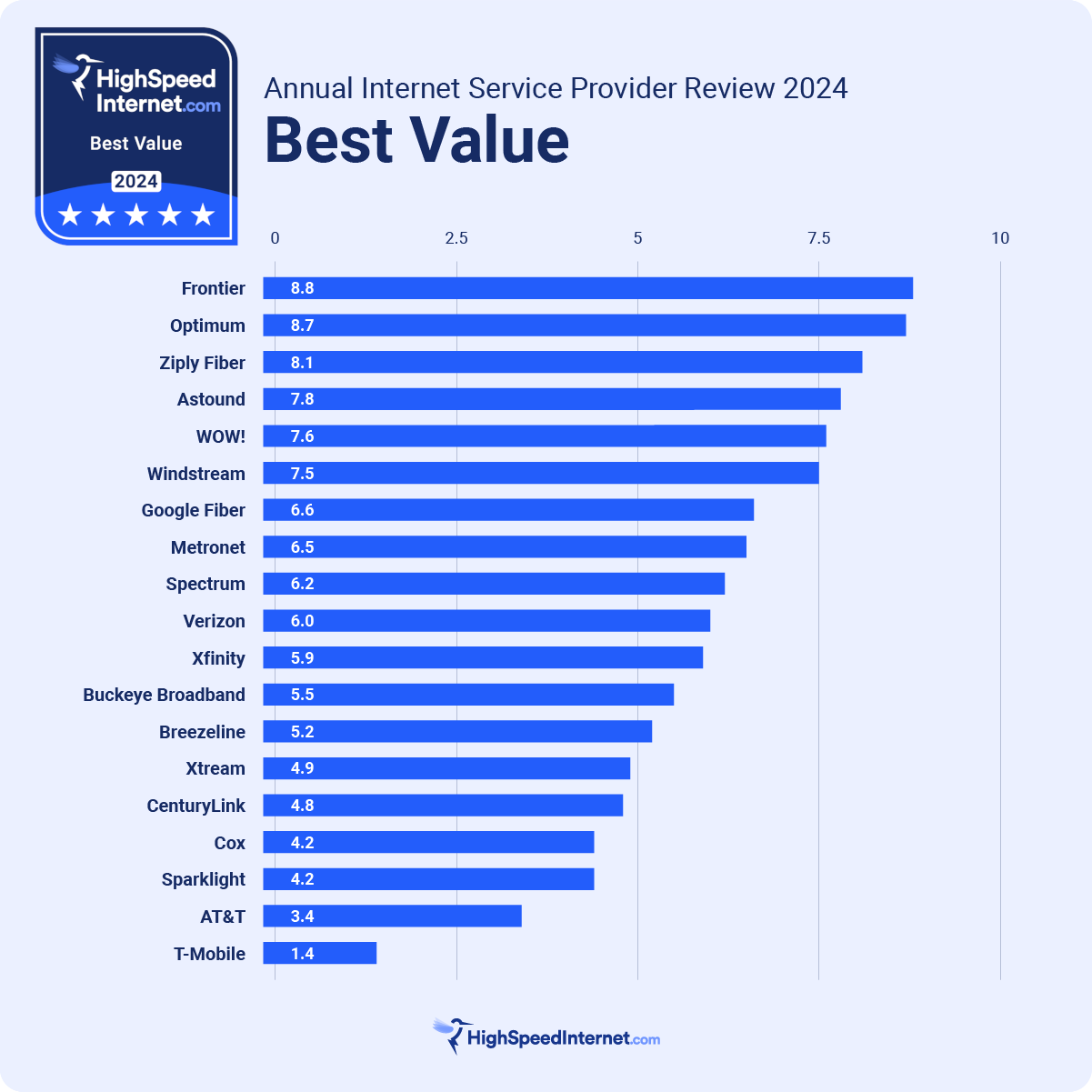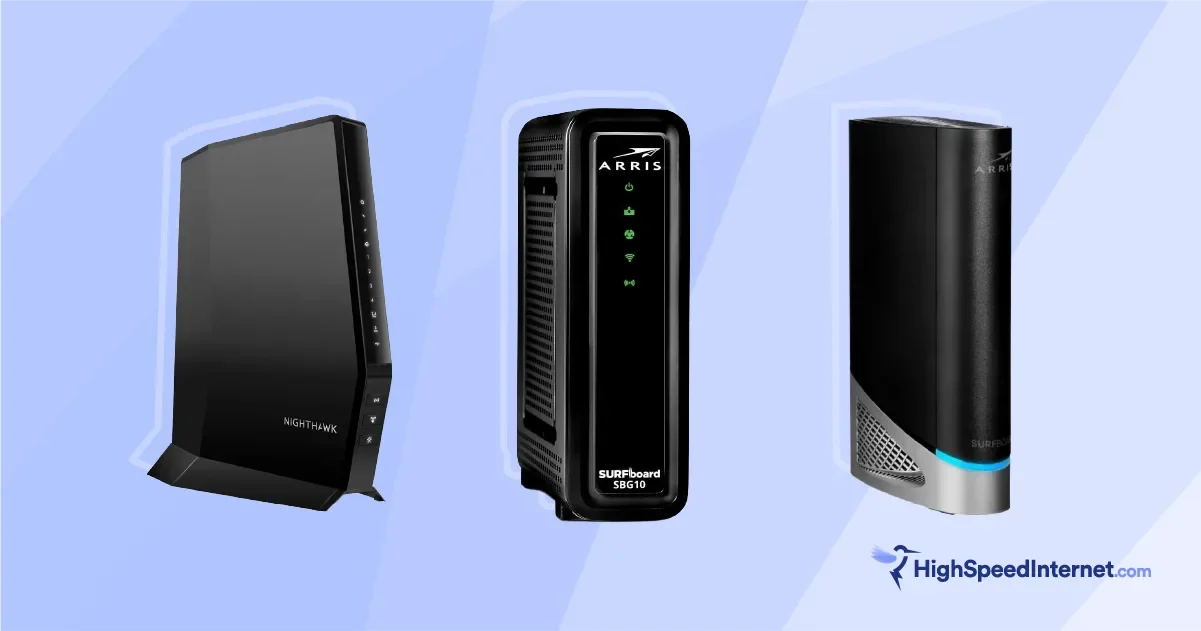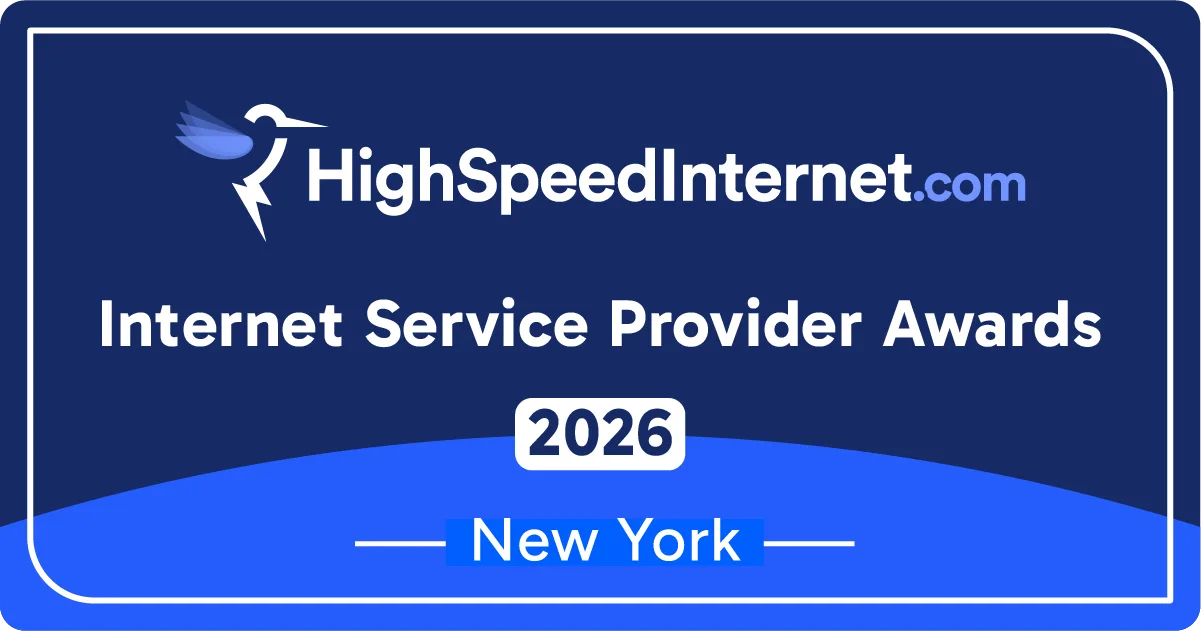Best Value Internet Providers 2024: Frontier
Frontier uses its growing fiber reach to deliver the best deal for internet customers in 2024
Oct 15, 2024 | Share
Annual Review 2024, Data and Research, Featured

When we asked over 7,000 internet customers what mattered most when choosing an internet provider, price was the most popular answer. And we agree; the best internet plan on the planet doesn’t mean a thing if it doesn’t match your budget. However, high-quality internet service isn’t optional in 2024, and with the bandwidth needs of the average household increasing every year, nobody wants a slow internet plan. But which should you prioritize: a low price or high performance? Our latest value analysis shows that with the right internet service provider (ISP), you can have both.
At HighSpeedInternet.com, our goal is to get you the best deal possible. That’s why we track internet plans and methodically assess value. Our team of internet experts studies the latest data and connectivity trends to determine which providers are delivering the plans people need. We use those findings to gauge the value of all major internet plans in the country.
This year’s Best Value ISP is Frontier, and its services prove a good deal doesn’t have to come with any compromises. Via its rapidly increasing fiber footprint, it provides top-quality internet at some of the lowest rates in the country while skipping the usual deal-killers, like data limits and extra fees. It stands out as one of the only ISPs using fiber to give customers a better deal, instead of an excuse to charge higher rates.
What matters most in an internet plan?
A high-value internet plan provides quality service at a good price. That sounds simple, but there’s a lot that can get in between you and a good deal. When we compared all the major internet plans in the country against customer needs, we found that most internet plans aren’t optimized well for the average household. So, while getting the most you can for your money is important, you can take that philosophy too far and wind up with something that just isn’t right for your household. In fact, ISPs are counting on it.
One of the biggest traps internet customers fall into is paying for more internet speed than they need. Most major providers now offer gigabit plans with 1,000Mbps speeds or even 2,000, 5,000, or 8,000Mbps speeds. These plans almost always offer more speed for the money. But if you’re one of the 91% of households in the U.S. with four or fewer people there’s really no way you can utilize all that extra speed, and you don’t see any benefit at all from purchasing more internet speed than you need. So why pay for gigabit plans? You probably shouldn’t be.
The importance of choosing a balanced plan goes both ways, as customers are sometimes lured into inadequate service agreements with a low rate. A slow plan speed is the most obvious sign of inadequate service, but often, more stealthy detriments lurk in the fine print. Data caps, contracts, extra fees, and even the wrong connection type can all add up to a bad experience.
The key to a good deal on internet service is finding the right speed and features at a low rate while avoiding terms and policies that cost you money or choke the performance and usability of your internet connection.
How we determine plan value
Our detailed Internet Plan Index tracks prices, speeds, data caps, tech types, and a whole lot more for all the major ISPs in the country. We use that information to determine which ISPs are giving customers the most bang for their buck. We ensure to tailor our methodology to provide value to the most people, prioritizing plans that make sense for the average customer.
While price and internet speed have the most impact on our value scoring, there’s a lot more that goes into creating a high-value internet plan. For example, you need to have enough data to avoid stressing over overage fees every month, and more upload speed, while not as impactful as download speed, can make a difference with certain applications, providing some additional value. Which connection type you choose matters, too, especially if you rely on your service for work, school, or demanding hobbies, like gaming. We process all these considerations and more through our customer-centric methodology to find out which providers are delivering the plans people need at prices they can afford.
Best Value ISP of 2024: Frontier

* Data from HighSpeedInternet.com Speed Test
Frontier came out on top as the Nation’s Best Value ISP in our assessment of the internet plans from all the major internet providers across the U.S. Frontier’s fiber-optic network hosts some of the most competitively priced internet plans that don’t cut any corners.
We love low prices, but we often find problems under the hood of budget internet plans: slow speeds, tiny data caps, hidden fees, the list goes on… but not with Frontier. You get excellent symmetrical speeds, unlimited data, free equipment, no sneaky fees, and, most importantly, a low rate, especially compared to the competition.
Frontier maintains a low price-to-speed ratio across its entire plan portfolio, but one plan stands out as a great fit for just about anyone: the Frontier Fiber 500. It makes it into our budget class with a sub-$50 monthly rate and symmetrical speeds over three times as fast as what you typically get from other providers in the same price range.
The Fiber 500 also includes all the extras you need for a top-notch internet service: unlimited data, a free router, free installation, and no hidden fees. The cherry on top is that you get a true fiber-to-the-premises (FTTP) internet network—the fastest and most reliable type of connection you can get. Let’s take a quick look at how Frontier’s value compares to other providers.
Frontier value takeaways
- Excellent price-to-speed ratio
- Budget plans that don’t skimp on speed or quality
- Price-friendly policies, like unlimited data, a free router, and no installation fee
- Top-quality FTTP connections for symmetrical bandwidth, low latency, and increased reliability
Frontier’s Fiber-optic 500 vs. the competition
| Provider & plan | Price | Speed download/upload | Data | Tech type |
|---|---|---|---|---|
| Frontier Fiber 500 | $44.99/mo. | 500Mbps/500Mbps | Unlimited | Fiber |
| Xfinity 500 Mbps | $55/mo. | 500Mbps/100Mbps | 1.2TB | Cable |
| Spectrum Internet Premier | $50/mo. for 12 mos. | 500Mbps/20Mbps | Unlimited | Cable |
| Verizon Fios 500 Mbps | $74.99/mo. | 500Mbps | Unlimited | Fiber |
| Google Fiber 1000 | $70.00/mo. | 1000Mbps/1000Mbps | Unlimited | Fiber |
Frontier’s value edge is plain as day when compared to other ISPs. Stacked against the nation’s largest provider, Xfinity, Frontier delivers 25% more speed for $10 less per month. Spectrum’s Internet 500 Mbps plan matches Frontier’s download speed but at a higher monthly rate.
And neither of those cable plans provides the symmetrical bandwidth enjoyed by Frontier’s customers. Verizon and Google Fiber do. Google Fiber even packs double the speed, but again, that comes at a hefty price. These aren’t cherry-picked plans, either. The table represents each ISP with the most competitive answer to Frontier’s Fiber 500 plan. Click on any provider name to see its full plan lineup.
Success follows the fiber
Frontier is no stranger to the significance of fiber-optic networks. It has been aggressively building and expanding its fiber reach for the past four years. But things weren’t always this way—Frontier’s been on both sides of the fiber coin.
Frontier’s success represents the near end of an absolute ISP comeback story. Back in 2020, Frontier filed for bankruptcy following difficult integrations with recently acquired networks and the declining value of legacy products like DSL and video service. Its DSL was too slow for modern needs and the video service had become a losing game, with high content costs eating all the profit. Dated offerings mixed with poor network management led to the company losing 1.3 million customers between 2016 and 2020. The ISP had not placed a high enough priority on upgrading to fiber—a mistake Frontier would not make twice.
In 2020, the bankruptcy may have looked like a plunge to rock bottom, but Frontier used it as a tactical slingshot to launch an ambitious fiber frenzy. The bankruptcy reduced the company’s debt by $10 billion. Frontier also sold off its northwestern networks for another $1.3 billion. (This is how Ziply Fiber was born.) The ISP then put everything it had into an aggressive investment in fiber acquisition and expansion. As it emerged from bankruptcy, Frontier planned to put $1.4 billion into fiber between 2020 and 2024 and increase the revenue mix from fiber up to 47% from the 31% estimated in 2019. It did even better.
Fast-forward to today and Frontier has increased its fiber customer base by almost 60%. Its latest quarterly report announced that fiber now accounts for more than 50% ($3.1 billion) of total revenue, with the ISP’s 2.1 million fiber customers making up 70% of its total customer base. Frontier has 6.5 million fiber locations with no plans of slowing down as it aspires to reach 10 million locations.
The focus on fiber has led to a financial turnaround and growth. 2023 was the first time Frontier saw a full year in Ebita growth in 10 years. And in Q1 2024, Frontier saw revenue growth for the first time since 2015. Frontier is in the green with one of the highest-value internet plan rosters in the nation powered by the best kind of internet connection you can get. Things are looking good for this ISP in 2024.
Top 5 internet service providers
Let’s take a brief look at the Nation’s Best Value ISPs, starting with our champion of 2024, Frontier!
#1—Frontier
| The good | The bad |
|
|
Frontier earned the highest value score with a strong value ratio, fast and reliable fiber service, and budget-friendly policies. It also avoided triggering any of our negative value modifiers.
#2—Optimum
| The good | The bad |
|
|
Optimum comes very close to the top with an excellent value ratio, budget-friendly plans, and no data caps. However, it lacks the symmetrical speeds and the increased performance of fiber internet.
#3—Ziply Fiber
| The good | The bad |
|
|
It’s no surprise to us that Ziply Fiber placed in the top five. Its Fiber Internet Gig plan manages to just make it into our budget category—it’s one of the most affordable gig plans you can get. It’s also one of the few fiber internet providers with a healthy selection of budget plans that start at just $20 per month. But Ziply Fiber’s expensive and slow DSL plan isn’t a great value.
#4—Astound Broadband
| The good | The bad |
|
|
Astound earns its spot as the second-best value cable ISP by offering good speeds at low prices. But its data caps are a drag, and most of its connections lack symmetrical speeds.
#5—WOW!
How to choose a high-value internet plan
While everyone’s connectivity needs are different, we’ve developed a few rules to make sure you get the best value while selecting a plan that works for your household. Follow these principles to get the most bang for your buck on internet service:
1. Choose the right speed
Having enough bandwidth is important, but wasteful spending on gigabit plans will just drain your bank account without giving you much in return. A good rule of thumb is to secure 100Mbps of bandwidth for every member in your household, with a bit extra to cover particularly internet-heavy days. This is why we like Frontier’s Fiber 500 plan so much, it provides enough speed for a four-person household with just the right amount of headroom.
2. Pick the right connection type
Not all internet services are the same. Fiber, cable, 5G, and satellite all have their pros and cons, and some aren’t suitable for all households. Fiber is the fastest and most reliable, in part due to its design but also because these are the newest networks in the country. If you count on your connection for remote work or high-demand applications like gaming, fiber is your best bet.
Cable internet is a close second, which is also fast and reliable, the only downside being you don’t get symmetrical bandwidth. If you’re using your connection for browsing, streaming, and other simple internet tasks, 5G home internet services offer the most convenient setups and maintenance due to being fully wireless.
3. Consider data caps, equipment fees, and term contracts
It’s important to consider these details because they have just as much potential to ruin your experience as speed and connection type.
- Data caps dictate how much data you can download per month, charging you extra fees if you go over.
- Equipment fees like modem and router rentals add to your monthly bill, costing you a considerable amount extra per year.
- Term contracts don’t just dictate how long you’re obligated to keep your service but also determine when you may experience a price increase.
With the right ISP, you don’t have to worry about any of these potential deal killers.
Methodology
Our value methodology looks for the providers that offer the best deals with a heavy preference for plans that make the most sense for the average household. We did this because it was an obvious cue from our research, speed test data, and customer survey findings. Money matters, and when inflation is on the rise, millions of households look for budget-conscious solutions to everyday expenses, including their internet bill.
We start by gauging plan value with a cost vs. bandwidth ratio. Plans with advertised speeds below 940Mbps carry the most weight as we consider these plans to have the most impact. For plans with speeds of 940Mbps and above, score influence starts to drop dramatically. Gigabit plans and above are not only considerably beyond the needs of the vast majority, but their prices often don’t fit with households on any kind of budget.
In an effort to further favor affordability, we apply a flat reward to any ISP with an internet plan for $50 or less and for any ISP that provides unlimited data with 50% or more of their plans.
Score anatomy (approx.): 66% value ratio, 34% affordability and policy
Author - Austin Aguirre
Austin worked as a broadband technician installing and troubleshooting countless home internet networks for some of the largest ISPs in the U.S. He became a freelance writer in 2020 specializing in software guides. After graduating with a BS in technical communication from Arizona State University, he joined the team at HighSpeedInternet.com where he focuses on home network improvement and troubleshooting.
Editor - Jessica Brooksby
Jessica loves bringing her passion for the written word and her love of tech into one space at HighSpeedInternet.com. She works with the team’s writers to revise strong, user-focused content so every reader can find the tech that works for them. Jessica has a bachelor’s degree in English from Utah Valley University and seven years of creative and editorial experience. Outside of work, she spends her time gaming, reading, painting, and buying an excessive amount of Legend of Zelda merchandise.




